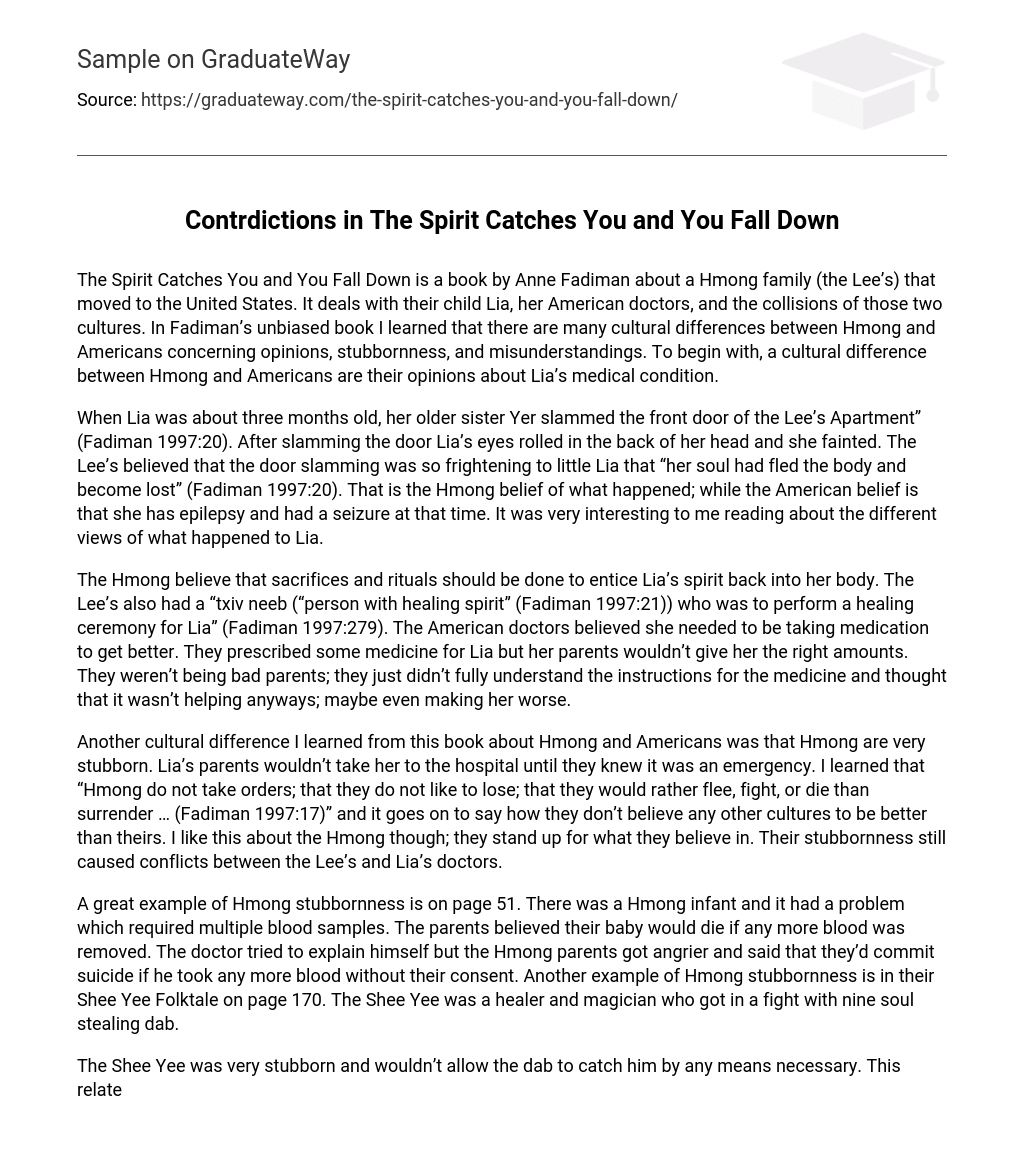The Spirit Catches You and You Fall Down is a book by Anne Fadiman about a Hmong family (the Lee’s) that moved to the United States. It deals with their child Lia, her American doctors, and the collisions of those two cultures. In Fadiman’s unbiased book I learned that there are many cultural differences between Hmong and Americans concerning opinions, stubbornness, and misunderstandings. To begin with, a cultural difference between Hmong and Americans are their opinions about Lia’s medical condition.
When Lia was about three months old, her older sister Yer slammed the front door of the Lee’s Apartment” (Fadiman 1997:20). After slamming the door Lia’s eyes rolled in the back of her head and she fainted. The Lee’s believed that the door slamming was so frightening to little Lia that “her soul had fled the body and become lost” (Fadiman 1997:20). That is the Hmong belief of what happened; while the American belief is that she has epilepsy and had a seizure at that time. It was very interesting to me reading about the different views of what happened to Lia.
The Hmong believe that sacrifices and rituals should be done to entice Lia’s spirit back into her body. The Lee’s also had a “txiv neeb (“person with healing spirit” (Fadiman 1997:21)) who was to perform a healing ceremony for Lia” (Fadiman 1997:279). The American doctors believed she needed to be taking medication to get better. They prescribed some medicine for Lia but her parents wouldn’t give her the right amounts. They weren’t being bad parents; they just didn’t fully understand the instructions for the medicine and thought that it wasn’t helping anyways; maybe even making her worse.
Another cultural difference I learned from this book about Hmong and Americans was that Hmong are very stubborn. Lia’s parents wouldn’t take her to the hospital until they knew it was an emergency. I learned that “Hmong do not take orders; that they do not like to lose; that they would rather flee, fight, or die than surrender … (Fadiman 1997:17)” and it goes on to say how they don’t believe any other cultures to be better than theirs. I like this about the Hmong though; they stand up for what they believe in. Their stubbornness still caused conflicts between the Lee’s and Lia’s doctors.
A great example of Hmong stubbornness is on page 51. There was a Hmong infant and it had a problem which required multiple blood samples. The parents believed their baby would die if any more blood was removed. The doctor tried to explain himself but the Hmong parents got angrier and said that they’d commit suicide if he took any more blood without their consent. Another example of Hmong stubbornness is in their Shee Yee Folktale on page 170. The Shee Yee was a healer and magician who got in a fight with nine soul stealing dab.
The Shee Yee was very stubborn and wouldn’t allow the dab to catch him by any means necessary. This relates to the Hmong culture because they stand firm in what they believe in and “are not intimidated by being outnumbered” (Fadiman 1997:17). Along with the stubbornness of the Hmong is my last point that the Hmong and Americans have cultural misunderstandings. Fadiman came “to believe that her [Lia’s] life was ruined not by septic shock or noncompliant parents but by cross-cultural misunderstanding” (Fadiman 1997:262).
Hmong once believed some crazy things about Americans. “It was said that Hmong women were forced into slavery, forced to have sex with American men … and with animals; that dinosaurs lived in America, along with ghosts, ogres, and giants” (Fadiman 1997:60). Another misunderstanding the Hmong had was about American doctors. They thought that “American doctors eat the livers, kidneys, and brains of Hmong patients … and that they are cut into pieces and put in tin cans and sold as food” (Fadiman 1997:32). So, Hmong don’t generally trust American doctors.
It is these misunderstanding and cultural differences that cause the conflicts. Some people thought that the Lee’s were neglecting Lia by not giving her the right amounts of medicine. I found that to be way off. Page 21-22 explains how Hmong regarded children as “the most prized possession a person can have” so that would be going against their culture to mistreat Lia. In conclusion, in The Spirit Catches You and You Fall Down I learned that there are many cultural differences between Hmong and Americans concerning opinions, stubbornness, and misunderstandings.
The beliefs of these two cultures are so different. If I had to assign blame for Lia’s tragedy I would blame the Lee’s only because I think that medicine would have helped her out a lot more if given properly from the beginning. I think that both behaviors were ethical though. The American doctors were trying to save Lia’s “life” while the Lee’s wanted to save her “soul” (Fadiman 1997:277). Both sides knew (in their minds), that they were doing what was right, so I’m still uncertain about which was more ethical.





